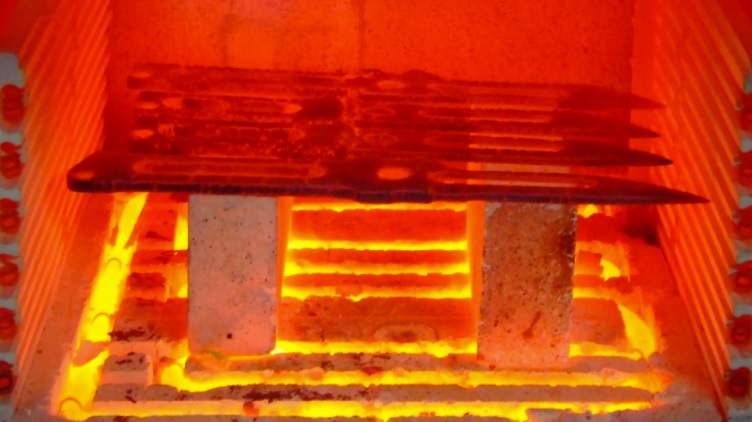Annealing is a heat treatment method that alters the microstructure of a material to alter its mechanical or electrical properties. Typically, in steels, annealing is employed to reduce hardness, increase plasticity and help eliminate internal stresses. Annealing may be a generic term and should refer to subcritical, intermediate or full annealing in a very type of atmospheres.
The process of heating a metal or alloy to an acceptable temperature for an explicit amount of time and so slowly cooling (generally with the chamber cooling) is termed annealing.
The essence of annealing is that the transformation of the pearlite when heating the steel to austenitizing. Once annealing, the tissue is near to that after equilibrium.
Purpose of Annealing:
- Reduce the hardness of steel, improve malleability, and facilitate machining and cold deformation process.
- The chemical composition and organization of uniform steel, refining grain, to enhance the performance of steel or to arrange for extinction.
- Eliminate internal stress and method hardening to stop deformation and cracking.
- Annealing and normalizing are primarily used for making ready heat treatment.
For components with low stress and low performance, annealing and normalizing can even be used as final heat treatment.
According to the heating temperature, the commonly used annealing method is divided into:
Phase change recrystallization annealing above the critical temperature:
- Complete annealing
- Diffusion annealing
- Incomplete annealing
- Spherification annealing
Annealing below the critical temperature:
- Recrystallization annealing
- Stress annealing
The selection of the annealing method generally has the following principles:
- The various steels of the hypoeutectoid structure usually choose complete annealing.
- In order to shorten the annealing time, isothermal annealing will be used.
- The spheroidizing annealing is mostly utilized in hypereutectic steel.
- When the request isn’t high, you’ll opt for not to complete annealing.
- Tool steel, bearing steel is usually used spheroidized annealing.
- Cold extrusion and cold upsetting components of low carbon steel or medium carbon steel are typically used spherified annealing.
- In order to eliminate the method hardening, recrystallization annealing is used.
- So as to eliminate the interior stress caused by numerous process, stress annealing is used.
- In order to enhance the inhomogeneity of the structure and chemical composition of high-quality steel, diffusion annealing is usually used.
Importance of Annealing:
Annealing is utilized to reverse the consequences of work hardening, which might occur throughout processes like bending, cold forming or drawing. If the material becomes too hard it can make working impossible or end in cracking.
By heating the material higher than the recrystallization temperature, it’s created a lot of ductile and thus able to be worked all over again. Annealing conjointly removes stresses that may occur once welds solidify. Hot rolled steel is additionally shaped and formed by heating it higher than the recrystallization temperature. Whereas steel and alloy steel hardening is common, alternative metals also can benefit from the method, like aluminium, brass, and copper.
Metal fabricators use annealing to help produce complicated components, keeping the material workable by returning them on the point of their pre-worked state. The method is vital in maintaining ductility and reducing hardness after cold working. Additionally, some metals are toughened to extend their electrical conduction.
Annealing with Alloys:
Annealing will be administered with alloys, with a partial or full toughen being the sole ways used for non-heat treatable alloys. The exception to this is with the 5000 series alloys, which might tends to low temperature stabillisation treatments.
Alloys are annealed at temperatures of between 300-410°C, depending on the alloy, with heating times starting from zero.5 to three hours, depending on the scale of the work piece and therefore the variety of alloy. Alloys ought to be cooled at a most rate of 20°C per hour till the temperature is reduced to 290°C, after that the cooling rate isn’t necessary.
Advantages:
The main benefits of annealing are in however the method improves the workability of a cloth, increasing toughness, reducing hardness and increasing the plasticity and machinability of a metal.
The heating and cooling method additionally reduces the bearableness of metals whereas enhancing their magnetic properties and electrical conductivity.
Disadvantages:
The main disadvantage with annealing is that it is a time intense procedure, counting on that materials are being annealed. Materials with high temperature necessities will take an extended time to cool down sufficiently, particularly if they’re being left to cool down naturally inside an annealing furnace.
Annealing is utilized across a range of industries wherever metals need to be worked into advanced structures or worked on many times.
We at KERONE have a team of experts to help you with your need for annealing techniques in various products range from our wide experience.

